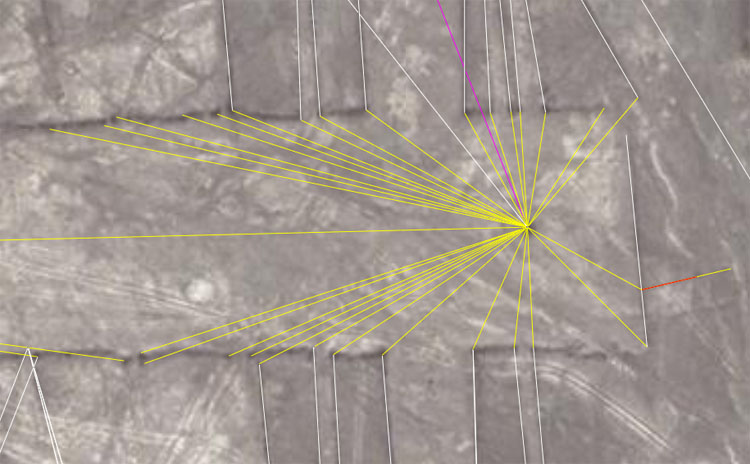
Let's look at more of the codes extending from the Eastern cairn surveying marker:

The surveying method employed at Nazca to construct the geometric design patterns is duplicated in modern times by surveyors preparing a building site. A convenient benchmark position is decided upon and a peg driven into the ground (generally over in a quiet corner under a tree beyond reach of the concrete trucks and with a good view of the entire site). On modern building sites that defining peg is ultra-important and the site surveyor's theodolite is set up there to shoot the first angles and determine building elevations. A solid, protective cover is put over the peg, when not in use, and anyone disturbing it risks being "hung, drawn and quartered", with full approval of the entire building crew.
At this Nazca site a cairn stone pile was built to serve the function of the benchmark surveying position for the eastern side of the rectangle. Another carefully placed cairn, based on a coded length and angle from the eastern cairn, was set up on the western side of the rectangle to work from on that end. The western cairn, like its eastern counterpart, determined where the "back-sight" positions commenced, which ultimately determined what the totality of the geometric design would finally look like. The fact that the final geometry is quite abstract, should have been a clue to our archaeologists that a wide variety of tutorial lengths and angles were being incorporated. Each yellow line shown above is coded by way of length and angle. It was, obviously, the task of the student to accurately determine the exact values encoded and then explain back to the tutor the significance of those values in navigation, cyclic astronomy or calendar position determinations, etc.
So, let's identify the meaning of each line shown:

1. This distance is 378 feet at an angle of 252-degrees
He sent down to the Talmudic schools of Pumbedita and Sura [located in Babylon] and brought up thousands of rabbis, and opened up synagogues and schools, and his people became what we call Jews. There wasn't one of them who had an ancestor who ever put a toe in the Holy Land. Not only in Old Testament history, but back to the beginning of time. Not one of them!' (Benjamin H. Freedman). For further in-depth information about the conversion of the Khazars to the Talmudic-Pharasee religion CLICK HERE
The reader should be aware that any reference to "Hebrew" Weights, Measures or Volumes and systems of metrology mentioned herein have no direct association whatsoever to any latter system devised by the Jewish Turko-Khazars , whose advent was about 13-hundred years years later than the last dying remnants of the Hebrew nation and geographically removed from Jerusalem by about 1000-miles northwards. If the Jewish-Khazar people adopted any ancient Babylonian standards of metrology at the time of conversion to the Talmudic-Pharisee religion, then direct relationships to the ancient Hebrew standards will exist, as the early epoch values used by the Babylonian and Hebrew nations were derived from the same parcel of significant numbers used, yet earlier, in Egypt and Sumeria, etc.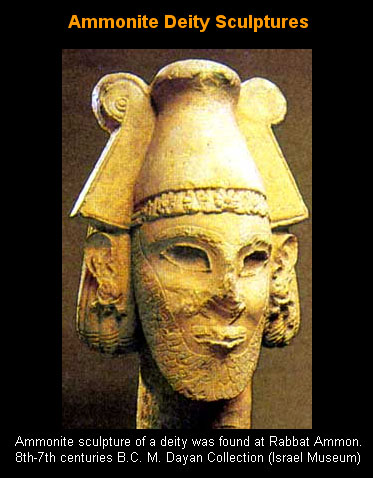 |
Another Jewish
scholar writes: As is the universal
rule, the circumference of the head of the male is greater than that of
the female by about 2.5 cm. (1 inch). Another point worth noting is that
(wherever data are obtainable) the circumference of the head among the
Jews is, as a rule, greater than that among the races with whom they dwell. Left: The Ammonite people were Hebrews and the sculpture dates from a period just before the Hebrew civilisation fell to powerful invaders, resulting in the loss of the Northern Kingdom (724 BC) and Southern Kingdom (586 BC) of the Israelite tribes. Most of the Hebrews escaped to Egypt or to their European cousin nations and Mediterranean island possessions, with many going to Spain (Iberia... which means Hebrews). The Biblical Hebrew word for Spain was Sepharad, from which the term Sephardim was derived. The Babylonian conquerors and occupiers of the Hebrew Southern Kingdom were themselves dispersed by the Romans, 656 years later, in 70 AD, with most fleeing back to Babylon or Ethiopia and others down the Mediterranean to countries like Spain. The Hebrews were not Babylonians and had an altogether different religion. The Babylonians were not Ashkenazi Turko-Khazzars. |
As stated, the angle of this line from the eastern cairn to the corner position where a secondary line commences is 252-degrees.
A huge amount of additional information could be added here about the merits of the value 252 and its use in ancient navigation. The value also featured very prominently in calculations to do with the lunar cycle within the lunisolar Sabbatical Calendar system and it occurs copiously on other scattered remnant structures, by way of length or angle, from continent to continent.
2. The length intended was 378.125-feet and the angle was 70.4-degrees (180-degrees opposed to 250.4-degrees).
As stated, there were several navigational methods, based upon particular number families and, under the Greek use of the numbers "6&7" combined, a mile was set at 5250 British Standard feet or 5000 Greek feet. This method of navigation produced wonderful results in positional plotting and was widely used by the cousin nations, but other European nations preferred to use a system based upon the number "11". Under this second system a mile was 5280-feet (30-feet longer). By this second system the side length of the Great Pyramid was symbolically read as 756.25 feet or 3-inches longer. This meant that two circumnavigations of the Great Pyramid was 6050-feet for 1-minute of Earth equatorial arc circumference.
Under this convenient reading of the equatorial circumference, the Earth was considered to be 24750-miles around using the "11" number family mile of 5280-feet. This standard for the mile persisted in Britain into modern times and is still used in the United States. An analysis of very early Scandinavian or Germanic measurements shows wide usage of an 11-system also. The early Vikings are known to have used a rule of 11-standard British inches . Researcher Gary Andersen, who devoted 10-years to studying Viking Standards, states: 'Fot: In doing the research for this I found that there were actually two measurements for the Fot. One was very early and ran at exactly 11 inches, the other was almost 1.03 feet.' (Note: The second "Fot" that Gary Andersen refers to was a specialised one based upon the PHI ratio and this was used by all the cousin nations for creating perfect, round volume vessel tubs (of varying capacities, depending on national preference for use in the marketplaces). The refined "Fot" referred to by Anderson was intended to be precisely 12.3608-inches [6.1804-inches X 2] or 1.0300666-feet. More about this later, as most values found at Nazca are PHI related.
On many open-air university sites like Nazca or Avebury Henge, the values for the mile at 5250-feet or the mile at 5280-feet will be typically displayed side by side. The return degree-angle, in this case, is 70.4-degrees.The value of 70.4 feet would be 1/75th of a mile @ 5280-feet.
3. This length is 302.4 feet at an angle of 66.6666-degrees (66 & 2/3rds).
The degree angle, in this instance, is typical of many degree angle readings, which were in 3rds (.3333333), 6ths (.16666666), 7ths (.142857142), 8ths (.125), 9ths (.1111111), 11ths (.09090909), 16ths (.0625), or even 25ths (.04), etc. Although the "7th" value looks horrendous when shown here as a decimal-fraction, it was as easy for the ancient mathematicians to manipulate as an other common fraction. The Roman foot is read as 11.664-inches in some calculations, but in practice was 11.6666666-inches (11 & 2/3rds inches, which is a simple fraction). A Roman pace was, in real overland measuring practice, 58.3333333-inches or 5 Roman feet. There would be 5.4 increments of 66.66666-degrees in 360-degrees.
In scientific calculations to do with the period of the Moon or volume capacities within market-place vessels, the 11.664-inch value for the Roman foot was used. We know, however, that the use of this increment pre-dates the Romans by millenniums and was only adopted by them from a wide selection of other Egyptian measurements. The Egyptian "Theban" volume measure was 11664 cubic inches.
4. The distance to this mark is 283.5-feet at a return angle back to the cairn of 65-degrees.
The angle, in this instance (65-degrees), is an expression of the value 13 or 130. Under the Sabbatical Calendar system the agrarian or peasant farmer's method of counting consisted of 7-days for a week, 4-weeks of 28-days duration each for a month and 13-months for a year... culminating in a count of 364-days for the raw count year (1.25-days of error accrued per annum). This system was allowed to persist for 7-solar years running concurrently with 7.2-lunar years. All corrections to the solar shortfall (8.75-days) were made during a festival at the end of the 7-year Sabbatical cycle. The number 13, therefore, features prominently in the calendar count of months in any given year. Ancient Druidic calendars of Europe showed 13-months, with each named after a tree, on some calendars, or an animal on others.
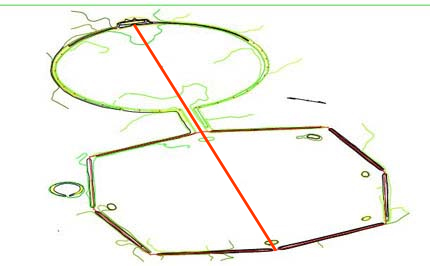
An oblique angle view down onto the huge Octagon earth-embankment complex of Newark, Ohio. The red line shown, running from an altar flat to the extremity of the end gate, was designed to be 2835 feet, or the same length as one circumnavigation of the Khafre Pyramid. Alternatively, the circle embankment part of the site would perfectly encompass the Great Pyramid, with the circle crown just brushing each corner.
5. This distance is 280-feet to the spot where one of the trapezoid sides begins, at a return angle back to the cairn of 63-degrees.
The degree angle in this instance is 63 and this value also relates strongly to calendar, as well as navigational counts. On the ancient Celtic Calendar of Coligny brass plaque of France there is, essentially, provision for 128 sections of half month counts, which alternate between counts of 14 & 15-days. The average for full months is 29.5-days, but this multi-use tracking device of solar & lunar positions can be read (with the option of including two special "CIALLOS" or calculation sections) in terms of 1890-days ÷ 64 = 29.53125 (lunar) or 1890-days ÷ 63 = 30 (solar). The sum of 189 feet was 1/4th of the length of the Great Pyramid.
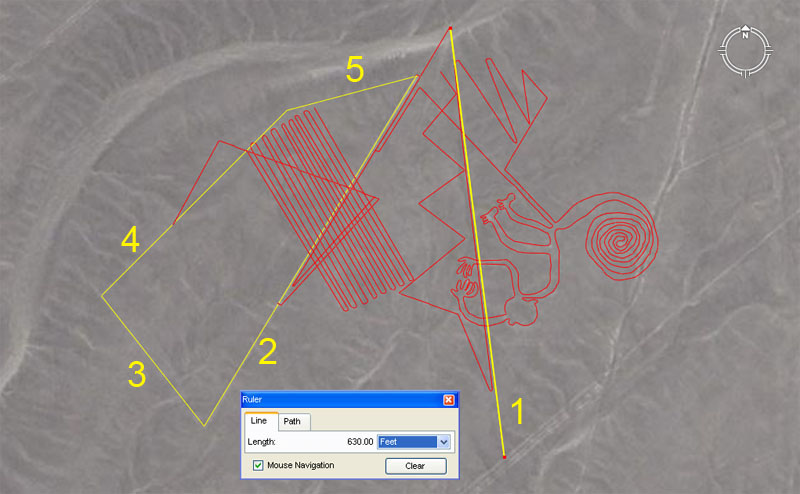
The glyph pictures of Nazca are generally built around
a central line running through them, which is carefully coded by way of length
and angle. On some of the bird glyphs, with their long straight beaks, it's
the beak itself that defines the angle of flight or heading and contains in-built
coded information.
On the Monkey glyph, a line (1) runs parallel to
the body line and defines the central codes of the glyph. The Google Earth ruler
shows the length of this line to be 630-feet or 1-Greek stadia (see panel) at
an azimuth angle of 172.8-degrees (a very dynamic navigational code). In both
length and angle the coding is navigational, although the "63" value
is equally valuable in calculations to do with the calendar. The straight, ground-lines
shown above, associated with the Monkey glyph, appear to give the following
coded readings:
The zigzagging lines immediately adjacent to the monkey's hands and leading to the tail, would have been very useful in teaching principles of navigation at sea. Sailing ships, at the mercy of the wind, have to tack on one angle and then upon another in order to work their way to a destination. In this exercise the navigator was ever-involved in doing mental arithmetic en-route, followed by accurate positional plotting at the termination of each "zig" or "zag". Before attempting navigation at sea, the difficult, demanding art had to be very thoroughly learnt by grueling practice and repetition on land, using the sun or moon by day and the stars by night as celestial points of reference.
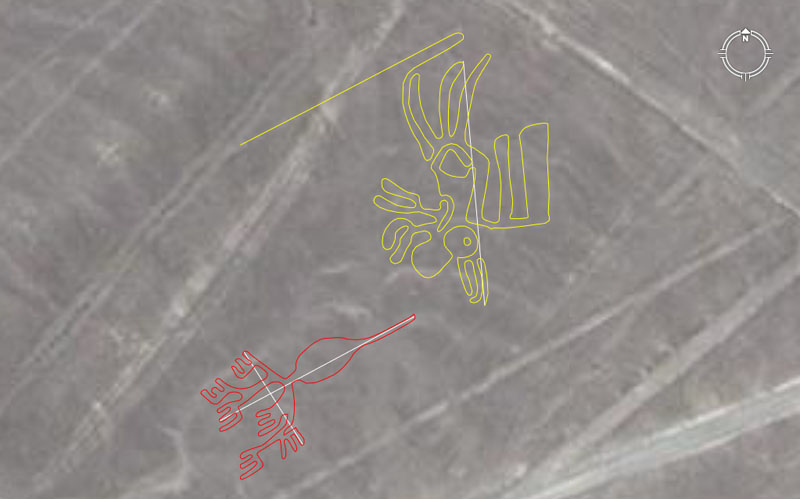
The Vulture glyph at Nazca (drawn in yellow) sits near a line that runs for 320-feet at an angle of 63-degrees. The orientation of the Vulture or path of flight is 175-degrees azimuth (a navigational value, when using the Greek mile of 5250-feet or for lunar cycle calculations).
The strange little bird (drawn in red) that sits beside
the Vulture heads across the pampa at an azimuth angle of 61.8034-degrees
(coding the PHI reciprocal value used for fabricating perfect capacity, round
tubs from which to dispense goods (grain, etc.) in ancient marketplaces. The
bottoms of the tubs were made in allotments of 6.18034-inches
and might be 1, 2, 3, or more increases of the value. The British Bushel tub
was 3 X 6.18034-inches for the base diameter, meaning
that it achieved exactly 270-square inches of base
surface. Once sides were added, which rose above the base 8-inches in height,
the capacity of the bushel was 2160-cubic inches
(lunar code).
The ancient British formula for fabricating the tubs was preserved (in very
slightly drifted form) in the Old
English Winchester Standard, which described a
bushel as, "any round measure with
a plain and even bottom, being 18.5 inches wide throughout and 8 inches deep".
The original bushel base would have been fabricated according to the formula:
10-inches ÷ 1.6180339 (PHI) = 6.18034-inches ....
X 3 = 18.54102-inches (essentially 18 & 6/11ths).
The length of the bird appears to be 156.25-feet (navigation) and the width
appears to be 77.76-feet (navigation) @ 147.65625-degrees (147 & 21/32nds
... lunar code).
6. The distance is 226.8-feet and the angle back to the cairn is 60.75-degrees.
As stated, the design length of the Great Pyramid is 756-feet and the total for 3-sides is 2268 feet. As stated, the design height of the Great Pyramid to its flat top altar floor is 453.6 feet, which is 2 X 226.8-feet. This length at Nazca is, therefore, half the vertical height of the Great Pyramid. Greek Historian, Herodotus, who visited Egypt in about 450 BC was told by one of the Egyptian priests that:
'and the pyramid is square, each side measuring eight hundred feet, and the height of it is the same'.
In consideration of this it is important to realise that there were many different measuring rules, depending upon the type of calculation to be done, and one fashioned to divide the Great Pyramid's length (756-feet) into 800-parts would be 11.34-inches (half of 22.68). If Herodotus is stating here that the height of the Great Pyramid was also being divided into 800-parts, then 453.6 feet divided by 800 = 6.804-inches. The lunar nutation cycle (Major Standstill till Major Standstill) takes 6804-days to complete.
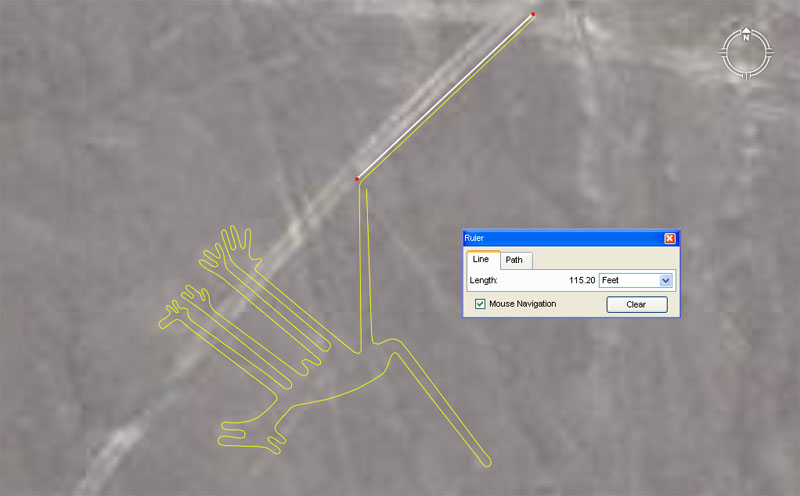
A line extending from the base of the dog glyph tail determines the orientation or path of travel for the dog across the pampa. The line (shown with a Google Earth "measured distance" line sitting adjacent) was, apparently, fashioned to be the very important coded length of 115.2-feet (navigation). The line sits on an azimuth angle of 226.8-degrees (lunar & navigational coding). The length of the long, straight back leg of the dog is 60.75-feet (lunar) and it extends on a return angle of 129.6-degrees (Precession of the Equinoxes coding). Note: Under the Sumerian-Babylonian Royal "Weights" standard, a Shekel was either 129.6 grains under the "single" standard or 259.2 grains under the "double" standard. The Precession of the Equinoxes endures for 25920-years to complete one cycle (with the Sun spending 2160-years in each of the 12 Houses of the Zodiac).
The degree angle in this instance (60.75) is lunar coding also and a progression based upon this value produces a whole raft of essential numbers for calculating the lunar period within the Sabbatical calendar system. Under this lunisolar system the Sun was tracked for 7-solar years (2556.75-days) and the Moon was tracked for 7.2-lunar years (2551.5-days). On the 6th day after the commencement of the solar count, the Druids started the lunar count (at the time of the mistletoe ceremony) so that the two counts ended on the same day 7 solar years later. The sum of 2551.5-days ÷ 60.75 = 42 (6 X 7). The Spider glyph at Nazca has a lne running adjacent to the body, which shows the orientation or direction of travel for the spider across the pampa. The line is 255.15-feet long and lies on an azimuth angle of 255.15-degrees.
7. The distance is 216 feet and the angle is 56.7-degrees. The value 216 was extremely important to ancient astronomers. Consider the following:
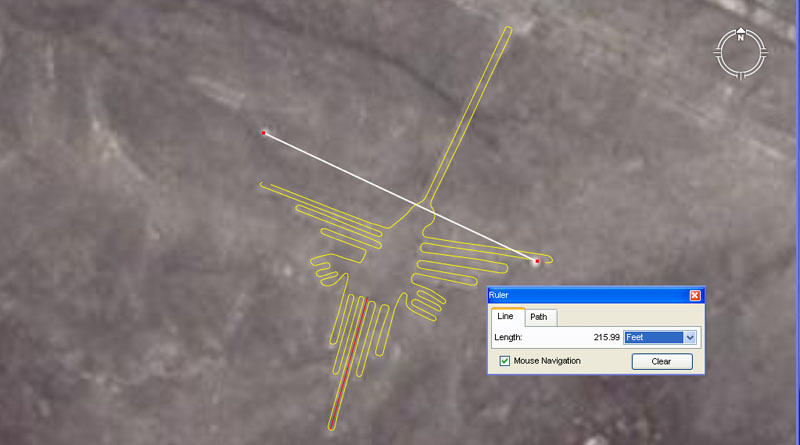
Two cairn markers sit to each side of this Nazca Hummingbird
glyph, one of which straddles the edge-line of the wing. The intended distance
between cairn centres appears, positively, to have been 216-feet
at an azimuth angle around from north of 259.2-degrees
(to a very small tolerance of error). The intended overall length of the Hummingbird
appears to have been 324-feet, which also related
to the 25920-year value describing the duration
of the Precession of the Equinoxes (324-years would be 1/80th of the period).
Unfortunately the tip of the beak has been smudged and damaged slightly, so
another possible code was 320-feet (navigation).
Other inbuilt codes included
(a) the beak
points directly towards 25.2-degrees and this is
a strong navigational code (one side length of the Great Pyramid is 756-feet
or 252-feet X 3); (b) the centre tail plume points
directly towards 15.625-degrees (15 & 5/8ths) and this is part of a strong
navigational mathematical progression.
The angle in this instance (56.7-degrees) is also lunar coding, It is part of the 113.4, 226.8 progression, discussed in no. 6.
8. The distance is 180-feet and the angle is 48.6-degrees. Both numbers are dynamic.
The degree angle of 48.6 contains a code much used in calendar calculations and navigation. The design length of the Celtic Calendar of Colligny bronze plaque of ancient France is 4.86 feet. A convenient way of dividing up the lunar and solar period counts within the lunisolar Sabbatical calendar was in increments of 5.25-days (126-hours... the Hebrew Reed was 10.5 feet (126-inches) or 2 X 5.25-feet). Under the Sabbatical Calendar method, the difference between the lunar period (2551.5-days) and the solar period (2556.75-days) is 5.25 days. There were 486 periods of 5.25-days in the lunar span of 2551.5-days and 487 periods in the solar span. A Druidic Priest, with a calibrated staff 5.25-feet long, would have been able to calculate both the solar and lunar positions within the Sabbatical cycle using the staff. The Roman mile was 4860-feet or 5000 Roman feet of 11.664-inches (also considered to be 11.66666 in certain types of calculations). The value was of such importance that Stonehenge was positioned so that the "first glint" of the Summer Solstice sunrise occurs at 48.6-degrees azimuth on the horizon.
9. The distance is 124.416-feet and the angle back to the cairn is 24-degrees.
The distance aspect is giving recognition to a value, which, when enlarged, indicates half the equatorial size of the Earth, according to the Great Pyramid standard (24883.2-Greek miles), Half that value is 12441.6-miles. It is highly probable that other pegs would have existed on this line to render additional readings of 125-feet (decimal) and 126-feet (Greek foot, Reed, stadia, etc., for navigational and lunar readings).
The 24-degree angle coding relates to hours in a day or a multitude of other duodecimal (twelfths) divisions, including those within the 360-degree circuit. Lines running up the faces of the Great Pyramid would intersect in the air at just over 480-feet of vertical height above the desert floor or just over 26.4 feet above the flat floor altar of the pyramid. The 12, 24, 48 progression was very important to all manner of ancient calculations.
10. The distance is 113.4-feet and the angle back to the cairn is 6.25-degrees.
The 113.4-feet value is a part of a very important lunar progression (see commentary for position 6). It's likely that an additional peg on this line would have offered tutorials for a length of 115.2-feet (navigation and lunar to a lesser degree, but featuring in some lunar calculations).
The degree angle of 6.25 codes a value which is very important to a decimal family of numbers, as well as to lunar, calendar and navigational calculations. Some examples are: 6.25, 12.5, 18.75, 25, 31.25 (note: there were 3.125-miles in an ancient British League), 37.5, 43.75, 50, 56.25....112.5 (note: 1/32nd of 360-degrees is 11.25).... 168.75 (a major navigational and lunar code, copiously represented at Nazca), etc.
11. This distance is 112-feet at an angle of 177.1875-degrees from the cairn to the position in the corner where a secondary, offshoot line commences.
The 112 progression was very important to navigation and also provided values for lunar calculations. Some examples are: 112 (this value in pounds, based upon much earlier usage, was adopted by Henry VIII for the hundredweight), 224 (The British ton is 2240-pounds), 336 (in feet 33.6 is 1/3rd of 1-second of equatorial arc under the Great Pyramid standard), 448, 560 (The are 56 post positions on the Aubrey Circle at Stonehenge, which are very important to calendar counts), 672 (hugely important navigational number...1008 (the sum of 100.8 feet was 1-second of Earth equatorial arc. It was also the internal width of the Sarsen Circle at Stonehenge in one cross measure).
The angle in this instance (177.1875-degrees... 177 & 3/16ths) codes half the lunar year of 354.375-days or 6 lunar months of 29.53125-days (29 & 17/32nd-days or 29-days and 12 & 3/4ths hours).
. 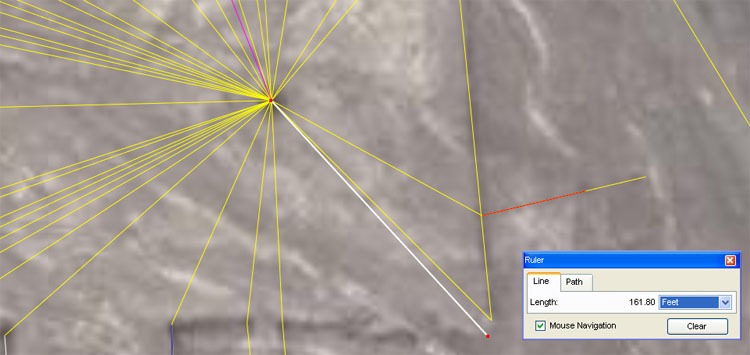
Unfortunately, no clear mark now exists to designate the exact, former position of the corner, but some comparative analysis would indicate that this very important position was accorded the honour to be coded to the PHI ratio. The distance would have been something very close to 161.8-feet at an azimuth angle of 137.5-degrees. The PHI ratio is 1: 1.6180339 and it was centrally important to the concept of "civilisation" inasmuch as the correct fabrication of accurate, "round" volume vessel tubs for the marketplace depended upon the formula, 10 ÷ 1.6180339.
PHI was incorporated copiously into the great edifices of the Mediterranean and Europe from remote antiquity. PHI relationships were secretly built into the cathedrals of Europe by the masonic guilds, under the watchful but patently ignorant gaze of Catholic inquisitors, who abhorred such "relics" of Paganism, but lacked the mathematical skill to detect them.
A good example of the use of PHI is found in the Great Pyramid itself. Consider the following:
Despite the fact that the Great Pyramid was built without a capstone, it was still possible to include a theoretical one in ongoing calculations or coding, based upon where lines up the face from the bottom converged at a common point above the pyramid. Considering that the base length was 756 feet and the face angle 51.84-degrees, the point where all lines converged above the pyramid was, essentially, 480 feet of vertical height. Any marginal residue beyond 480 feet would likely have been trimmed, as 480 was the sought after code for vertical height.
THE CODED PHI ANGLE & THE PHI BASED PYR. ACRE CODE.
If one uses simple trigonometry to work out the side length of
the full pyramid, including the theoretical, non-existent capstone, the length
to the centre apex would be (Adj. ÷ 51.84 Cos.) = 611.7894615
feet.
Alternatively, if one used a PHI method of Adj. (378 feet) X PHI (1.6180339)
= 611.6168142 feet.
It will be observed that the calculated PHI length is only about 2 inches less
than the length achieved by straight trigonometry. The ancient astronomer/ mathematicians
were coding a PHI related angle for the Great Pyramid simultaneously to the
standard angle of 51.84-degrees. The whole edifice was designed to clearly code
PHI relationships. For example:
Let's consider the Great Pyramid on the basis of PHI and the ratio relationship
(in Egyptian pyramid acres identified from the writings of Herodotus) between
the 4 faces, compared to the ground area that the Great Pyramid covers.
The surface area of each face of the theoretical full pyramid, complete with
a (symbolic) pointed capstone, = 611.6168142 feet of side length X 378 feet
(1/2 the base length) = 231191.11558 square feet.
Because there are 4 faces, their combined square footage amounts to 924764.6231
square feet. This translates to 32.10988275 Egyptian pyramid acres of 28800
square feet each.
The base area measured 756 feet X 756 feet or 571536 square feet, which equated
to 19.845 Egyptian pyramid acres of 28800 sq. ft each. A perfect PHI relationship
exists between this (symbolic capstone included) total side acreage and that
of the base: 32.10988275 ÷ 19.845 = 1.6180339
(PHI).
Ancient measurements often incorporated a "rounded" form of PHI in readings of an overall length. For example, the 756-feet base length of the Great Pyramid would also equate to 466 & 2/3rds X 1.62-feet (rounded PHI foot). The 2551.5-day duration of the lunar count within the Sabbatical Calendar system equates to 1575 X 1.62... (157.5-feet would be 1/4th of a Greek stadia of 630-feet). Surveyor, Professor Alexander Thom, detected a repetitive interval of length on Megalithic British sites, which he dubbed the Megalithic Yard and assigned a value very close to 32.4-inches (16.2 X 2).
THE PI CODE.
Alternatively, a nigh-on perfect PI (3.1416
to 1) code is also built into the vertical height of the Great
Pyramid, based upon the slope angle up the diagonal faces of 51.84-degrees and
a base side length of 756'. Under such circumstances, lines coming up each of
the four faces would intersect at a vertical height of 481.04297651 feet.
Two side lengths at the base of the pyramid would equate to 1512' (756' X 2).
Therefore: 1512' ÷ 481.04297651' (vertical height) = 3.14317. Under such
close proximity circumstances a perfect PI relationship would exist if the pyramid
achieved a height 2.88-inches greater in this symbolic geometric relationship
between vertical height and two base side lengths.
With the vertical height of the Great Pyramid, to this point of intersection,
read symbolically as 480', the ratio between two side lengths (1512') and the
vertical height would be 3.15 to 1 and relate to increments within (what became)
the Greek measurement system (where a half "stadia" was 315').
In the above picture, the "best guess" line to the corner proves to be set at 137.5-degrees azimuth angle from the cairn. This is part of a progression related to the "11" family of numbers and the British mile. There would be 120 increments of 137.5-feet in an ancient British League of 16500-feet (3.125-miles). The sum of 137.5-feet would be 25 British fathoms of 5.5 feet each. (Note: the old fathom was 5.5-feet and this persisted with the British Merchant Navy until recent times).
12. This distance is 157.5-feet, with a return angle back to the cairn of 315-degrees.
An astute observer will already have noted that 157.5 is half of 315 and that the Greek stadia (Stadium) was 630-feet. One circumnavigation of the Great Pyramid was 4.8 Greek stadia.
Anytime the value of 157.5 is encountered (or increases/ decreases of the same) it is simultaneously coding tutorials for both the Greek stadia and the PI ratio together. Whereas PI is rendered as 3.1416 to 1, the half-stadia is 315-feet and 1/100th of the value is 3.15 (a rounded form of PI...just as the value 1.62 codes a rounded form of PHI). Both ratios occur copiously on ancient coded structures from continent to continent.
13. This distance is 121.5-feet at 118.8-degrees return angle to the cairn.
The 121.5-feet value is a strong lunar code, much used in Sabbatical Calendar calculations and there would be 21 periods of 121.5-days in the 2551.5-days (7.2-lunar years) of the lunar count alongside the solar count of 2556.75-days (7-solar years). The value of 121.5-feet would also be 125 Roman feet of 11.664-inches or 25 Roman Paces of 58.32-inches. With a progression based on this value, both lunar and navigational calculations could be done simultaneously.
The degree angle in this instance has a value of 118.8-degrees. A mathematical progression based upon this value produces numbers like 356.4, much used in navigation. The "Y" Holes Circle at Stonehenge has a diameter of 178.2-feet (half of 356.4). A progression that included 118.8 was used in an alternative navigational method, which viewed the Great Pyramid's length as 756.25-feet. Under this method, the Earth's circumference was set to 24750-miles of 5280-feet each (130680000-feet). A progression based upon this degree angle at Nazca goes: 118.8, 237.6, 356.4, 475.2, 594,.... 1306.8.
14. The distance of this secondary, outrigger line is 54-feet at an angle of 76.8-degrees.
A mathematical progression based upon the number 54 is extremely important to both lunar and navigational counts under the ancient Egypto-European systems. The sum of 54-feet would be 1/14th of the Great Pyramid's length at 756-feet. A progression goes: 54, 108, 162 (PHI is 1.6180339 & a series of ancient "rounded PHI" measurements were based upon 1.62), 216 (1/12th of the Precessional cycle is 2160-years... the Babylonian Homer volume was 21600 cubic inches, etc.), 270 (due West in degrees), 324, 378, 432, 486, 540, 594, 648, 702, 756, etc. All of the numbers are dynamic and occur continuously throughout the Nazca geometry by way of lengths and angles.
The angle in this instance is 76.8-degrees. This is a very important navigational value, based upon the Great Pyramid geodetic standard for the equatorial circumference of the Earth of 24883.2-miles @ 5250-feet each. The external face of the lintels capstones at Stonehenge once represented 11.52-feet (11 & 13/25ths) each X 30 lintels = 345.6-feet (76.8-feet X 45). Each face of of the Great Pyramid was, literally, 8-Eyptian acres (of 28800-square feet each) of surface area or 230400 square feet. That equates to 76.8 X 3000 square feet per face.
15. The intended code of distance in this two part line appears to have been 85.05-feet and the angle remains the same at 76.8-degrees.
This value is lunar and relates very strongly to the Sabbatical Calendar system, A mathematical progression based upon 85.05 goes: 170.1 (the lunar nutation cycle endures for 6804-days or 1701 X 4), 255.15 (the lunar count within the Sabbatical Calendar system was 7.2-lunar years or 2551.5-days), 320.4 (the Khafre Pyramid @ 708.75-feet per side coded 2835-feet of perimeter or 30240-inches) etc.
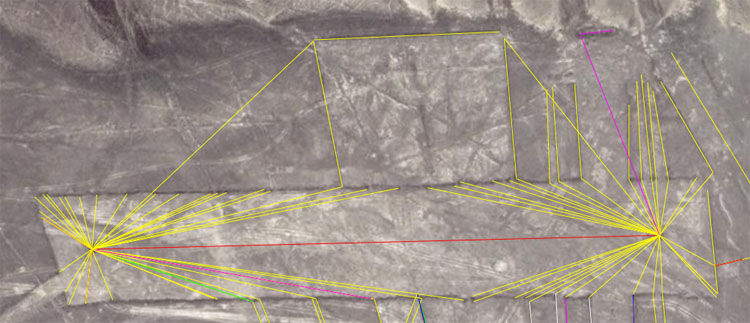
A red line is seen to extend from the western cairn to the eastern cairn and lines run from the cairns to backstop positions where new lines commence. A purple line runs from the eastern cairn (right) to a group of purpose placed boulder markers in the northeastern sector. The distances and angles from the eastern cairn to these markers contain subtlety different codes, all of which were absolutely important for inclusion within the ancient parcel of scientific numbers used by the European cousin nations.
16. The intended coded distance between the cairns (red line above) was 1088.64-feet (1088 & 16/25ths) @ 88.59375-degrees west to east.
The distance would be 1/120000th of the equatorial circumference of the Earth (130636800-feet.... 24883.2 Greek miles) under the Great Pyramid's geodetic code. This distance at Nazca was 13063.68-inches in design length. The distance would also be exactly 630 Egyptian Royal Cubits of 20.736-inches each. This was one of the largest (1.728-feet) of the several in use by the Egyptians and the coffer within the Great Chamber of the Khafre Pyramid was 5 of these Royal Cubits in length (103.68-inches). Paving stones at the base of the Great Pyramid were also made to this cubit.
Remember that there were always two elements in play in this decipherment. The measured length was an indicator of the number that had been encoded. All of these numbers had to be memorised by the student and it was the responsibility of the tutor to teach how and where the numbers were used and up to the initiate student to commit that knowledge to memory. The measuring rope or staff used to extract the value acted as a mnemonic device to trigger an understanding of what had been encoded. Refinements or fractional elements beyond what could be detected visually from measurement had to be learnt by rote and repetition.
The angle is equally dynamic @ 88.59375 (88 & 19/32nds). This value, in days, would be 3-lunar months of 29.53125-days each (29 & 17/32nds).